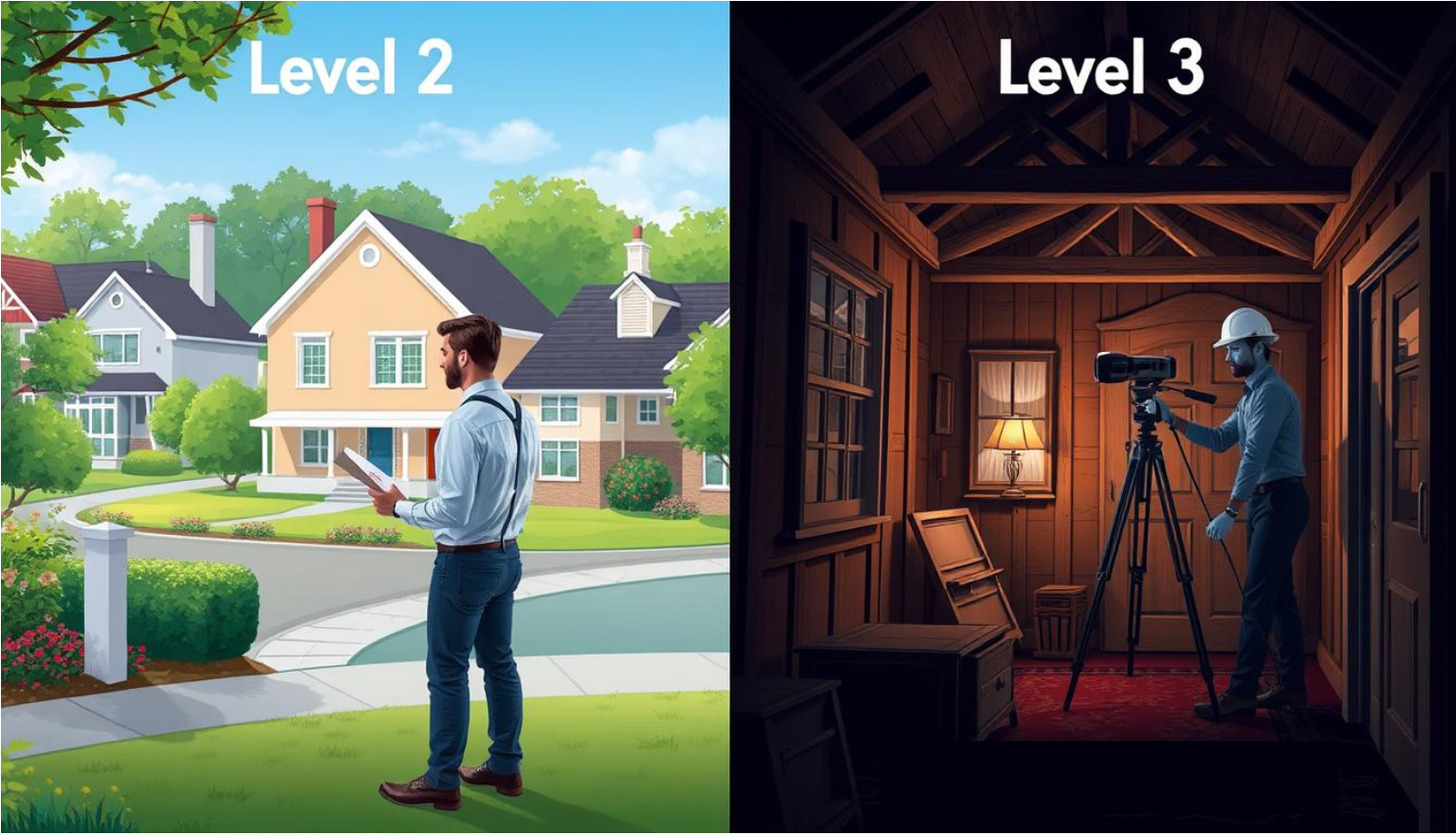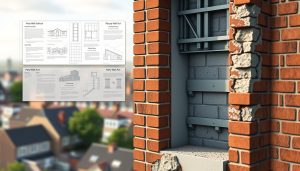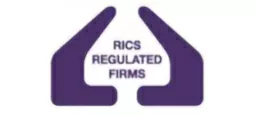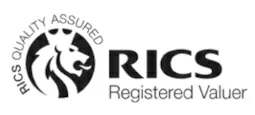Acquiring a property necessitates a home survey, which is a critical step in the transaction. With most home buyers experiencing a 3-6 month wait to complete their purchase, and not so many finishing in 1-2 months, selecting the appropriate survey level is imperative. The distinction between a Level 2 and Level 3 survey is fundamental to aligning with your specific requirements. A home survey uncovers hidden issues, affording you a detailed investment insight and averting unforeseen expenses.
In the UK, 57% of respondents cited moving house as their most stressful life event. To alleviate this stress, evaluating the property’s age, condition, your financial capacity, and future intentions is essential. Level 2 surveys are more economical and suitable for structures constructed within the last 150 years. In contrast, Level 3 surveys are advisable for older properties or those with substantial modifications.
Key Takeaways
- Understanding the differences between Level 2 and Level 3 surveys is critical for making an informed decision.
- A home survey can uncover hidden issues and provide a clear investment overview.
- Level 2 surveys are suitable for standard properties and offer a clear investment overview.
- Level 3 surveys are recommended for properties over 50 years old or those which are larger, more expensive or with significant alterations.
- Choosing the right survey option can help mitigate the stress of moving house.
- It’s essential to consider the age and condition of the property, budget, and future plans when deciding between a Level 2 and Level 3 survey.
- A RICS-accredited professional can ensure reliability and accuracy in home survey reports.
Understanding Home Survey Basics
In the UK, grasping home survey basics is essential when purchasing a property. A home survey offers a professional evaluation of a property’s state, shedding light on its structure, possible defects, and required repairs. In England, Wales, and Northern Ireland, such assessments are standard for prospective buyers. Scotland, on the other hand, mandates a Scottish Home Report for properties listed on the market.
The significance of home surveys is immense. They can prevent significant financial losses by uncovering repair needs before a purchase is finalised. The Royal Institution of Chartered Surveyors (RICS), Chartered Institute of Building (CIOB) and Residential Property Surveyors Association (RPSA) ensures that surveyors meet rigorous standards, providing various survey levels tailored to property types and ages.
What is a Home Survey?
A home survey entails a visual examination of a property’s condition, encompassing accessible areas like the roof, walls, and floors. Surveyors scrutinise for signs of damage, wear, and defects, compiling a report detailing their observations.
The Evolution of Home Survey Standards in the UK
UK home survey standards have evolved significantly, adapting to market changes and technological advancements. Today, a range of surveys exists, from the RICS Level 2 Survey to the RICS Level 3 Survey, each with varying levels of detail and complexity.
Why Home Surveys Matter
Home surveys are critical as they offer buyers vital insights into a property’s condition, aiding in purchase decisions. They can also serve as leverage for price negotiations or highlight repair needs early on. By familiarising oneself with home survey basics and their importance, buyers can make well-informed choices, mitigating unforeseen expenses.
| Survey Level | Description | Cost |
|---|---|---|
| RICS Level 2 Survey | A fair inspection of the property’s condition | £600-£1,500 |
| RICS Level 3 Survey | The most detailed survey of the property’s condition | £700-£2,500+ |
The Comprehensive Guide to Level 2 Home Surveys
A comprehensive guide to level 2 home surveys is vital for grasping the property condition of a prospective new residence. These surveys are ideal for most properties, delivering a thorough evaluation of the property’s overall state. They pinpoint any critical issues that demand immediate attention.
These assessments are invaluable for relatively new dwellings that seem to be in sound condition. The survey will present a report utilising a traffic light system. This simplifies the property condition understanding, clearly highlighting urgent attention areas.
Level 2 home surveys offer several advantages:
- They provide a detailed assessment of the property’s condition.
- They identify significant issues that may necessitate attention.
- The report is categorised by a traffic light system for straightforward comprehension.
It’s important to note that level 2 home surveys are typically adequate for properties in fair condition and standard construction types. Yet, for older or non-standard constructions, a level 3 survey might be more appropriate.
In terms of cost, level 2 home surveys are generally more affordable than level 3 surveys. Prices range from £600 to £1,500. The survey report is usually completed within 5 days. This offers a swift and effective means to understand the property condition of a prospective new home.
Deep Dive into Level 3 Home Surveys
A level 3 home survey offers a detailed examination of a property’s condition, highlighting defects and risks. It is invaluable for properties that are older, unconventional, or have undergone significant alterations. The survey process entails a thorough structural assessment and technical inspection. This is to uncover existing faults and predict future problems.
The survey covers all accessible areas, including hard-to-reach spaces like the roof. It details defects, their causes, and offers extensive advice on repairs and maintenance. This level of scrutiny is critical for buyers aiming to negotiate better terms and avoid unforeseen expenses.
- Structural defects: issues related to the foundation or building frame
- Dampness and mould: common indicators of larger problems
- Roof condition: problems such as missing tiles or leaks
- Electrical systems: identification of outdated or unsafe installations
Investing in a level 3 home survey equips buyers with a thorough understanding of the property’s state. This knowledge is essential for making informed decisions. It also serves as a foundation for negotiations, enabling buyers to request adjustments in the purchase price. Ultimately, a level 3 home survey safeguards against unexpected costs, ensuring a seamless transaction.
| Survey Type | Description |
|---|---|
| Level 1 | Suitable for new properties in good condition, namely flats. |
| Level 2 | Suitable for standard properties in good condition, namely modern houses. |
| Level 3 | Suitable for older, larger, more expensive, unconventional, or substantially altered properties. |
Home Survey Level 2 vs Level 3: Key Differences
Understanding the key differences between Level 2 and Level 3 surveys is essential when considering home survey options. The Level 2 Homebuyer Report, the most common RICS survey, is ideal for properties constructed within the last 150 years. In contrast, Level 3 surveys are tailored for larger, older, or significantly altered structures. They offer a more in-depth evaluation of the property’s structure and fabric.
The primary distinction between Level 2 and Level 3 surveys is their level of intricacy and the types of properties they are most appropriate for. Level 2 surveys are non-intrusive, focusing on surface-level issues. In contrast, Level 3 surveys involve a hands-on approach, including attic inspections and floorboard lifting. This hands-on inspection makes Level 3 surveys more fitting for properties requiring a more detailed examination.
Some of the key differences between Level 2 and Level 3 surveys include:
- Level of detail: Level 3 surveys offer a more detailed assessment of the property’s structure and fabric.
- Property type: Level 3 surveys are more suitable for larger, older, or significantly altered properties.
- Cost: Level 3 surveys are more expensive than Level 2 surveys, reflecting the more detailed and thorough nature of the inspection.
The choice between a Level 2 and Level 3 home survey hinges on the specific needs of the property and the buyer. By grasping the key differences between these two survey types, buyers can make an informed decision. This ensures they receive the appropriate level of inspection for their requirements.
Costs and Value Considerations
Understanding the costs and value of home surveys is essential. The price of a home survey varies based on the survey type, property condition, value, and size. Typically, a Level 2 survey, or HomeBuyer Report, costs between £600 – £1,500. In contrast, a Level 3 survey, or Building Survey, can range from £700 – £2,500.
Several factors influence these costs, including the surveyor’s time, the property’s condition, and any necessary repairs. For example, a HomeBuyer Survey usually takes 1-2 hours. A Building Survey, which is more detailed, can take 2-4 hours. An additional valuation for a Building Survey may add around £250 minimum.
It’s vital to assess the value each survey offers. A Level 2 survey is suitable for properties with conventional construction. On the other hand, a Level 3 survey is recommended for properties with structural issues or those undergoing major renovations. Selecting the appropriate survey level can save time and money, and aid in negotiating prices by highlighting necessary repairs.
When evaluating survey costs and value, consider the following:
- Property condition and age
- Surveyor’s expertise and time
- Potential repairs and renovations
- Budget requirements and constraints
By grasping the costs and value of Level 2 and Level 3 surveys, clients can make informed decisions. This ensures they’re getting the most value for their investment in property.
When to Choose a Level 2 Survey
A Level 2 Survey is ideal for most modern properties in excellent property condition. It offers a thorough assessment at a reasonable cost. When contemplating when to choose a level 2 survey, assess the property’s age and state. For newer properties that seem sound, a level 2 survey is often adequate.
Several factors influence the decision to opt for a level 2 survey:
- The property’s age and condition
- The presence of any possible defects or issues
- The necessity for a detailed overview of the property’s condition
Choosing a level 2 survey is a cost-effective strategy that offers insightful information on the property’s state. It’s vital to consider the balance between the costs and benefits of a level 2 survey against other alternatives, such as a level 3 building survey. For further details on level 2 surveys, visit Wimbledon Surveyors.
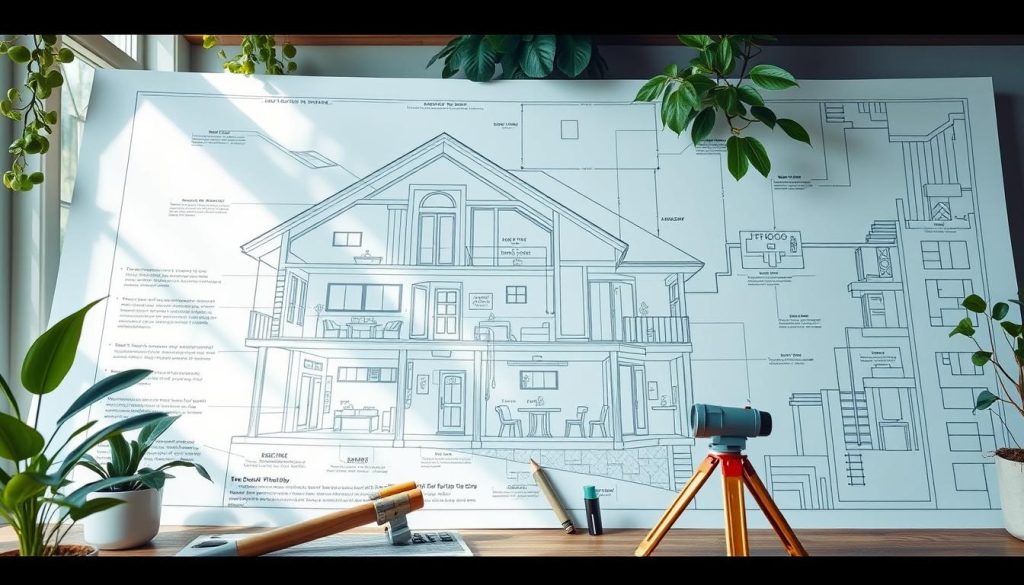
Ideal Scenarios for Level 3 Surveys
When evaluating a property’s condition, level 3 surveys emerge as the preferred option for specific structures. They are invaluable for period properties, which often present complexities necessitating a meticulous examination.
For ideal scenarios, a level 3 survey is advisable for properties exceeding 50 years, listed buildings, or those with extensions or developments. Such properties frequently harbour unique attributes and latent defects, demanding an exhaustive evaluation.
Period Properties
For period properties, a level 3 survey offers a nuanced insight into the building’s state, pinpointing any defects or latent issues. This is critical for investors aiming to secure a prudent investment.
The advantages of a level 3 survey for period properties are manifold:
- A thorough evaluation of the building’s condition
- Identification of any defects or latent issues
- A detailed report outlining repair and maintenance recommendations
Unusual Construction Types
Level 3 surveys are also apt for properties with unconventional construction. Such structures, due to their complexity, necessitate a detailed assessment to ascertain their safety and integrity.
Opting for a level 3 survey equips buyers with a deeper understanding of the property’s condition, empowering them to make informed investment decisions.
Understanding Survey Reports and Findings
Survey reports are vital for making informed decisions. They offer a detailed overview of a property’s condition, highlighting significant issues. The report’s sections, such as “Overall opinion,” “Property Details,” and “Elements,” aim to summarize key points and provide detailed information.
The survey reports and findings are essential for identifying risks and issues with the property. They include a visual inspection of the property, including the roof, walls, windows, and guttering. An evaluation of the grounds and shared areas is also conducted. Understanding these findings is critical for determining the necessary next steps and obtaining further quotes for investigations.
Some key aspects of a survey report include:
- Overall opinion: summarizes key notes and provides detailed information
- Elements of the property: includes details such as the number of rooms, loft spaces, and mains services
- Risks: details the property’s or its occupants’ possible risks
- Energy matters: provides an overview of the property’s energy efficiency, including heating, ventilation, and insulation
A surveyor’s declaration is included at the end of the inspection, officially signing off the completed survey. Suggestions for next steps are provided under “What to do now.” These insights help in addressing identified issues and obtaining further quotes for investigations. By understanding survey reports and findings, property owners and homebuyers can make informed decisions and take necessary steps to address property issues.
| Section | Description |
|---|---|
| Overall opinion | Summarizes key notes |
| Property Details | Includes details such as the number of rooms, loft spaces, energy ratings, and mains services |
| Elements | Details the property’s condition and possible risks to occupants |
Common Issues Identified in Both Survey Types
Home surveys often uncover several common issues, including structural concerns, damp and moisture problems, and issues with building services. These problems can significantly affect a property’s condition and value. It is vital for buyers to be informed about these issues.
Some prevalent issues in home surveys include:
- Subsidence caused by vegetation, such as trees
- Dry rot, which can spread rapidly if conditions are favorable
- Woodworm infestations, which can vary in severity
- Damp, which can affect structural integrity and health
Recent statistics reveal that up to 70% of houses built before 1999 may have Japanese knotweed, impacting mortgage terms. Issues with drainage systems, electrical systems, and roof problems are also common. Addressing these issues early can prevent costly repairs and safety hazards.
A home survey can uncover these issues, providing buyers with insights into the property’s condition and necessary repairs. Understanding common issues in both survey types allows buyers to make informed decisions, avoiding costly surprises.
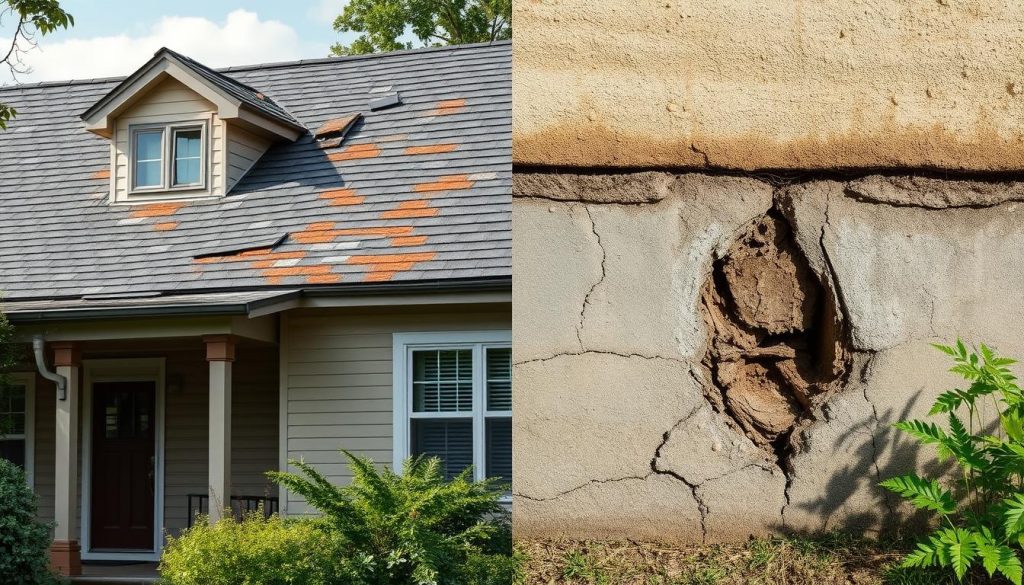
Below is a table outlining some common issues and their estimated costs:
| Issue | Potential Cost |
|---|---|
| Subsidence | £5,000 – £50,000 |
| Dry Rot | £1,000 – £10,000 |
| Woodworm Infestation | £500 – £5,000 |
| Damp | £1,000 – £10,000 |
Being aware of these common issues and their costs enables buyers to make informed decisions, avoiding unexpected expenses. It is critical to collaborate with a qualified surveyor to identify these problems and receive a detailed report on the property’s condition.
Making Your Final Decision
In the process of selecting a home survey, several elements are critical. The property type is a key factor, as various properties necessitate different levels of survey detail. For example, older or uniquely constructed properties might require a Level 3 survey for a thorough assessment.
Your budget factors also significantly influence this choice. A Level 2 survey might seem more economical upfront. Yet, a Level 3 survey offers deeper insights, potentially saving you from future, costly repairs. It’s vital to balance the costs against the benefits of each option, ensuring the long-term value aligns with your financial capabilities.
Ultimately, an informed final decision hinges on a detailed evaluation of your specific situation, the property’s state, and the survey’s findings. By meticulously assessing these elements, and considering your budget factors and property type, you can make a choice that reassures you and mitigates risks in the home acquisition journey.
- The age and condition of the property
- The complexity of the property’s design or construction
- Your budget and what you can afford to spend on a survey
- The level of detail and information you need to make an informed decision
By thoroughly examining these aspects and aligning your final decision with your property type and budget factors, you can select the home survey that best suits your requirements and offers the greatest value.
Working with Qualified Surveyors
Ensuring the precision and dependability of a home survey necessitates collaboration with qualified surveyors. These professionals, governed by the RICS, deliver an exhaustive evaluation of a property’s state, pinpointing any critical issues that demand attention. The advantages of engaging with qualified surveyors encompass:
- Accurate and reliable reports
- Detailed analysis and reporting
- Compliance with professional standards
A distinguished surveying firm boasts qualified surveyors who are entrenched in the locales they serve. This guarantees the provision of a dependable and precise report. The benefits of working with such entities include unwavering confidence and a profound comprehension of the property’s condition. By opting to work with qualified surveyors, one can make an enlightened choice when acquiring a property, sidestepping prospective pitfalls.
Aside from the aforementioned advantages, working with qualified surveyors affords a holistic grasp of the property’s condition, encompassing any prospective issues. This is invaluable when negotiating the purchase price or pinpointing areas necessitating renovation.
| Survey Type | Benefits |
|---|---|
| Level 2 Survey | Suitable for conventional properties in good condition |
| Level 3 Survey | Provides a more detailed analysis on higher value, older or larger properties |
Conclusion
The decision between a Level 2 and Level 3 home survey hinges on the property’s specifics, your budget, and your concerns. It’s not a decision to be taken lightly. Each option caters to different needs, making it essential to consider the property’s condition and your financial goals.
The RICS Level 2 Survey is ideal for homes in good condition. On the other hand, the Level 3 Survey is more suitable for older, larger, more expensive or neglected properties. Choosing the right surveyor is key to understanding the property’s state fully. This ensures you make a well-informed purchase.
Assessing the pros and cons of each survey type is vital. It helps you get the right level of insight to protect your investment. A detailed home survey is a wise investment. It offers peace of mind and safeguards your financial well-being.
FAQ
What is the difference between a Level 2 and Level 3 home survey?
The distinction between a Level 2 and Level 3 home survey hinges on the depth of analysis and the suitability for specific property types. A Level 2 survey, often referred to as a standard survey, is designed for the majority of fairly modern properties. It offers a thorough evaluation of the property’s condition. In contrast, a Level 3 survey is a more in-depth and detailed assessment and is recommended for properties over 50 years old, Listed Buildings, or those that have undergone significant renovations.
When should I choose a Level 2 home survey?
Opt for a Level 2 survey for most modern properties in good condition. It provides a detailed condition assessment at a more affordable price. This makes it a preferred choice for many homebuyers.
What types of properties are best suited for a Level 3 home survey?
A Level 3 survey is ideal for larger or more expensive buildings, period properties, unusual construction types, and properties requiring renovation. These properties benefit from the detailed assessment and reporting offered by a Level 3 survey.
How much do Level 2 and Level 3 home surveys typically cost?
Level 2 surveys are generally more affordable than Level 3 surveys. Yet, it’s important to weigh the cost against the benefits. A Level 3 survey provides a deeper insight into a property’s condition, which may justify the higher cost.
How do I understand the findings in a home survey report?
A survey report offers a detailed condition overview, highlighting significant issues. It’s essential to review the report thoroughly. Understanding the findings helps in making an informed decision about the property purchase.
What are the most common issues identified in home surveys?
Both Level 2 and Level 3 surveys commonly identify structural concerns, damp and moisture problems, and issues with building services. These issues must be carefully considered and addressed to ensure the property’s condition and safety.
Why is it important to work with qualified surveyors?
Collaborating with qualified surveyors is vital for obtaining accurate and reliable results. A qualified surveyor can provide a detailed assessment of the property’s condition, highlighting any significant issues that require attention.


